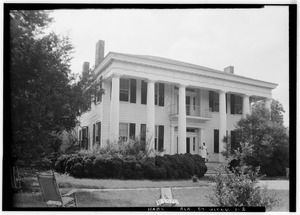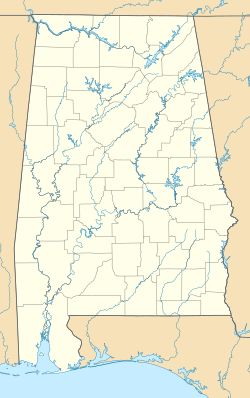Glenville, Alabama facts for kids
Quick facts for kids
Glenville, Alabama
|
|
|---|---|

Glennville Plantation in a 1935 HABS photo
|
|
| Country | United States |
| State | Alabama |
| County | Russell |
| Elevation | 463 ft (141 m) |
| Time zone | UTC-6 (Central (CST)) |
| • Summer (DST) | UTC-5 (CDT) |
| Area code(s) | 334 |
| GNIS feature ID | 119045 |
|
Glennville Historic District
|
|
| Area | 544 acres (220 ha) |
| NRHP reference No. | 79000402 |
| Added to NRHP | August 7, 1979 |
Glenville (sometimes called Glennville) is a small, quiet community in Russell County, Alabama, in the United States. It is an unincorporated community, which means it doesn't have its own local government like a city or town. Long ago, it was part of Barbour County.
During the Civil War, a group of soldiers called the "Glenville Guards" was formed here. They were part of Company "H" of the 15th Regiment Alabama Infantry. The center of Glenville is now a special place called the Glennville Historic District. This area has many old buildings from before the Civil War, and it was added to the National Register of Historic Places in 1979.
Contents
History of Glenville
Glenville was the very first lasting community in what is now Russell County. It was started in 1835 by a Methodist preacher named James Elizabeth Glenn. This happened after the Muscogee people were forced to leave their lands in what is known as the Trail of Tears.
The town quickly grew into an important place for business and culture in East Alabama. Besides the Methodist Church, Glenville had schools for boys and girls. These schools, like the Weyman School for Girls, were famous across the Southern states for their excellent education.
Glenville also had a post office, shops, a Masonic Lodge (a social club), and an inn where travelers could stay. The town officially became a city in 1854. Leaders hoped this would help them get a railroad line built through the town.
However, many local farmers did not want the railroad. Because of this, the railroad ended up going around Glenville. After the Civil War, farmers lost much of their power and influence. Without the railroad and with these changes, the town slowly became less important.
Where is Glenville?
Glenville is located in a countryside area in the southern part of Russell County. It is found along U.S. Route 431. The community is about 17 miles (27 km) north of Eufaula. It is also about 26 miles (42 km) southwest of Columbus, Georgia.
Population Changes
| Historical population | |||
|---|---|---|---|
| Census | Pop. | %± | |
| 1850 | 900 | — | |
| 1880 | 99 | — | |
| 1890 | 282 | 184.8% | |
| U.S. Decennial Census | |||
Glenville was counted in the U.S. Census in 1850. At that time, it was part of Barbour County. It did not appear on the census again until 1880. By then, its population was much smaller. This was because the county borders were changed, and Glenville moved into Russell County. The last time Glenville appeared on the census was in 1890.
Buildings and Styles
The historic district in Glenville includes 32 main buildings and 27 smaller buildings, plus 6 cemeteries. The most important buildings are the large plantation houses built before the Civil War. Most of these homes are in the Greek Revival style. This style often features tall columns and grand entrances, similar to ancient Greek temples.
The Methodist church, built around 1850, also shows the Greek Revival style. The Episcopal church, built in 1926, has a Gothic look. This style often includes pointed arches and tall windows. Later homes, built in the late 1800s and early 1900s for tenant farmers, are simpler. These smaller homes show how the town's wealth and importance changed over time.
Important Person
- William Curran Dawson was a former member of the Alabama House of Representatives. He was an important person from Glenville.
Images for kids








